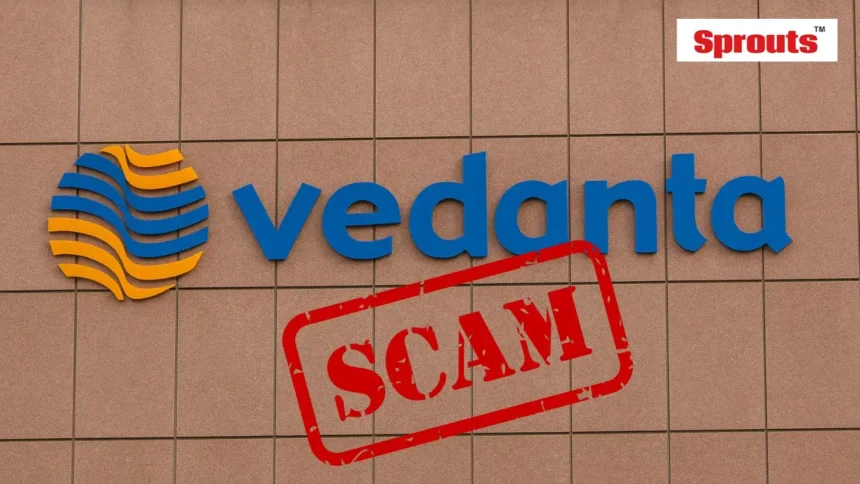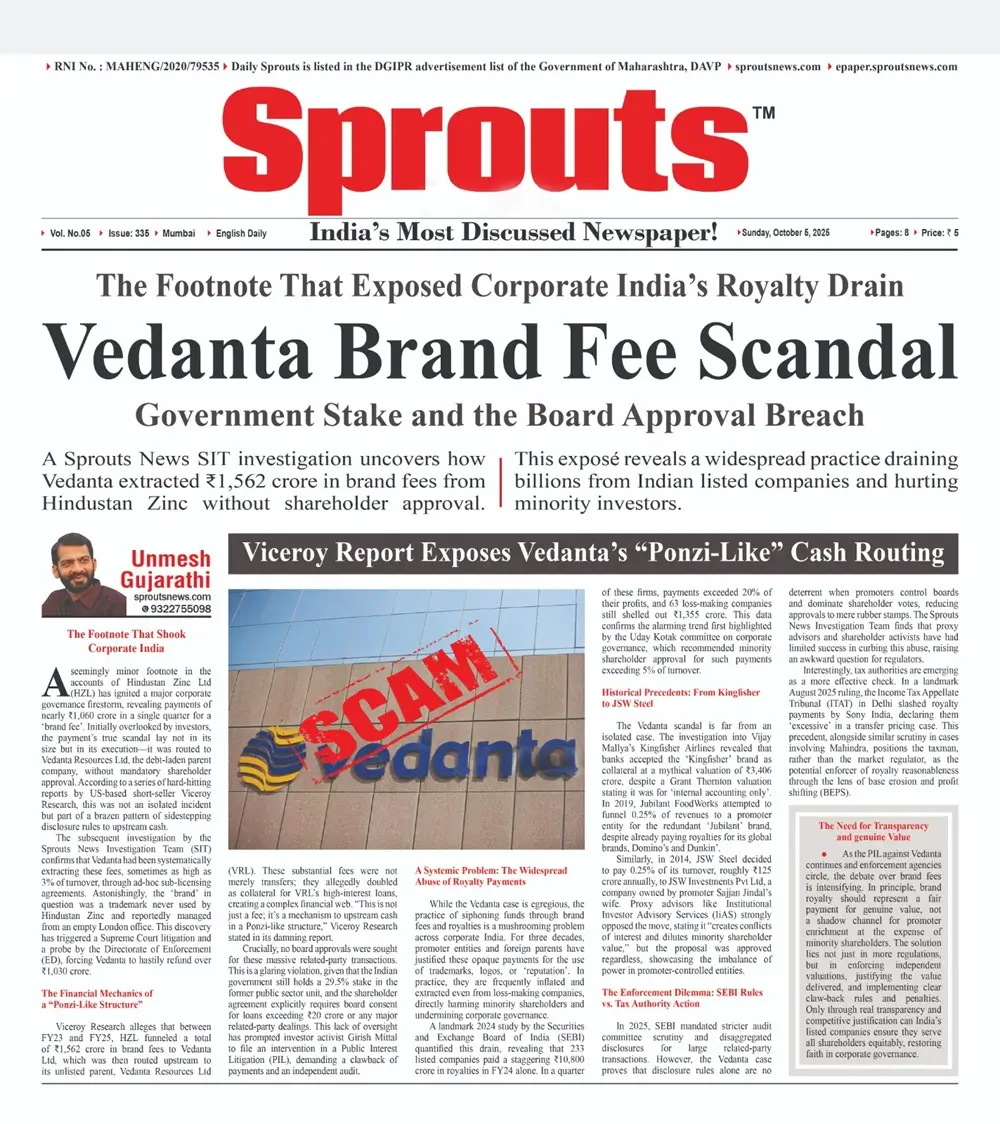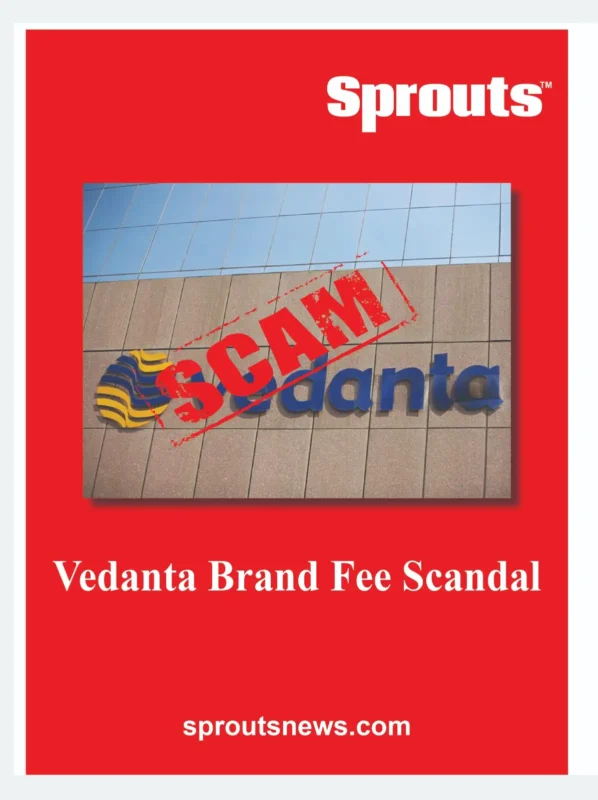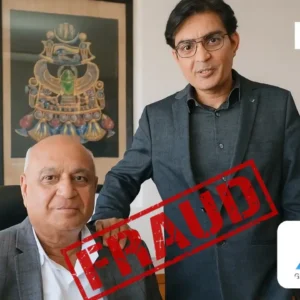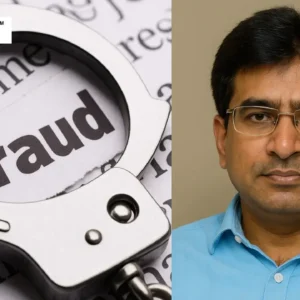Vedanta Brand Fee Scandal
• The Footnote That Exposed Corporate India’s Royalty Drain
• Government Stake and the Board Approval Breach
• Viceroy Report Exposes Vedanta’s “Ponzi-Like” Cash Routing
A footnote in Hindustan Zinc’s accounts has exploded into a ₹1,562 crore corporate scandal, exposing how Vedanta siphoned cash via dubious brand fees without shareholder approval. The Sprouts SIT investigation, backed by Viceroy Research reports, reveals a “Ponzi-like” structure draining Indian listed firms and hurting minority investors. The scandal has now reached the Supreme Court and triggered an Enforcement Directorate probe.
- Vedanta Brand Fee Scandal
- • The Footnote That Exposed Corporate India’s Royalty Drain
- • Government Stake and the Board Approval Breach
- • Viceroy Report Exposes Vedanta’s “Ponzi-Like” Cash Routing
- The Footnote That Shook Corporate India
- The Financial Mechanics of a “Ponzi-Like Structure”
- A Systemic Problem: The Widespread Abuse of Royalty Payments
- Historical Precedents: From Kingfisher to JSW Steel
- The Enforcement Dilemma: SEBI Rules vs. Tax Authority Action
- The Need for Transparency and genuine Value
Click Here To Download the News Attachment
The Footnote That Shook Corporate India
A seemingly minor footnote in the accounts of Hindustan Zinc Ltd (HZL) has ignited a major corporate governance firestorm, revealing payments of nearly ₹1,060 crore in a single quarter for a ‘brand fee’. Initially overlooked by investors, the payment’s true scandal lay not in its size but in its execution—it was routed to Vedanta Resources Ltd, the debt-laden parent company, without mandatory shareholder approval. According to a series of hard-hitting reports by US-based short-seller Viceroy Research, this was not an isolated incident but part of a brazen pattern of sidestepping disclosure rules to upstream cash.
The subsequent investigation by the Sprouts News Investigation Team (SIT) confirms that Vedanta had been systematically extracting these fees, sometimes as high as 3% of turnover, through ad-hoc sub-licensing agreements. Astonishingly, the ‘brand’ in question was a trademark never used by Hindustan Zinc and reportedly managed from an empty London office. This discovery has triggered a Supreme Court litigation and a probe by the Directorate of Enforcement (ED), forcing Vedanta to hastily refund over ₹1,030 crore.
The Financial Mechanics of a “Ponzi-Like Structure”
Viceroy Research alleges that between FY23 and FY25, HZL funneled a total of ₹1,562 crore in brand fees to Vedanta Ltd, which was then routed upstream to its unlisted parent, Vedanta Resources Ltd (VRL). These substantial fees were not merely transfers; they allegedly doubled as collateral for VRL’s high-interest loans, creating a complex financial web. “This is not just a fee; it’s a mechanism to upstream cash in a Ponzi-like structure,” Viceroy Research stated in its damning report.
Crucially, no board approvals were sought for these massive related-party transactions. This is a glaring violation, given that the Indian government still holds a 29.5% stake in the former public sector unit, and the shareholder agreement explicitly requires board consent for loans exceeding ₹20 crore or any major related-party dealings. This lack of oversight has prompted investor activist Girish Mittal to file an intervention in a Public Interest Litigation (PIL), demanding a clawback of payments and an independent audit.
A Systemic Problem: The Widespread Abuse of Royalty Payments
While the Vedanta case is egregious, the practice of siphoning funds through brand fees and royalties is a mushrooming problem across corporate India. For three decades, promoter entities and foreign parents have justified these opaque payments for the use of trademarks, logos, or ‘reputation’. In practice, they are frequently inflated and extracted even from loss-making companies, directly harming minority shareholders and undermining corporate governance.
A landmark 2024 study by the Securities and Exchange Board of India (SEBI) quantified this drain, revealing that 233 listed companies paid a staggering ₹10,800 crore in royalties in FY24 alone. In a quarter of these firms, payments exceeded 20% of their profits, and 63 loss-making companies still shelled out ₹1,355 crore. This data confirms the alarming trend first highlighted by the Uday Kotak committee on corporate governance, which recommended minority shareholder approval for such payments exceeding 5% of turnover.
Also Read: Who Is Shielding Thane’s Corrupt Encroachment Chief Shankar Patole?
Historical Precedents: From Kingfisher to JSW Steel
The Vedanta scandal is far from an isolated case. The investigation into Vijay Mallya’s Kingfisher Airlines revealed that banks accepted the ‘Kingfisher’ brand as collateral at a mythical valuation of ₹3,406 crore, despite a Grant Thornton valuation stating it was for ‘internal accounting only’. In 2019, Jubilant FoodWorks attempted to funnel 0.25% of revenues to a promoter entity for the redundant ‘Jubilant’ brand, despite already paying royalties for its global brands, Domino’s and Dunkin’.
Similarly, in 2014, JSW Steel decided to pay 0.25% of its turnover, roughly ₹125 crore annually, to JSW Investments Pvt Ltd, a company owned by promoter Sajjan Jindal’s wife. Proxy advisors like Institutional Investor Advisory Services (IiAS) strongly opposed the move, stating it “creates conflicts of interest and dilutes minority shareholder value,” but the proposal was approved regardless, showcasing the imbalance of power in promoter-controlled entities.
The Enforcement Dilemma: SEBI Rules vs. Tax Authority Action
In 2025, SEBI mandated stricter audit committee scrutiny and disaggregated disclosures for large related-party transactions. However, the Vedanta case proves that disclosure rules alone are no deterrent when promoters control boards and dominate shareholder votes, reducing approvals to mere rubber stamps. The Sprouts News Investigation Team finds that proxy advisors and shareholder activists have had limited success in curbing this abuse, raising an awkward question for regulators.
Interestingly, tax authorities are emerging as a more effective check. In a landmark August 2025 ruling, the Income Tax Appellate Tribunal (ITAT) in Delhi slashed royalty payments by Sony India, declaring them ‘excessive’ in a transfer pricing case. This precedent, alongside similar scrutiny in cases involving Mahindra, positions the taxman, rather than the market regulator, as the potential enforcer of royalty reasonableness through the lens of base erosion and profit shifting (BEPS).
The Need for Transparency and genuine Value
As the PIL against Vedanta continues and enforcement agencies circle, the debate over brand fees is intensifying. In principle, brand royalty should represent a fair payment for genuine value, not a shadow channel for promoter enrichment at the expense of minority shareholders. The solution lies not just in more regulations, but in enforcing independent valuations, justifying the value delivered, and implementing clear claw-back rules and penalties. Only through real transparency and competitive justification can India’s listed companies ensure they serve all shareholders equitably, restoring faith in corporate governance.

